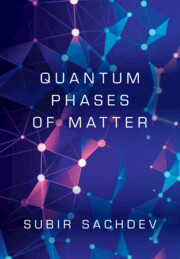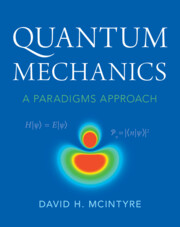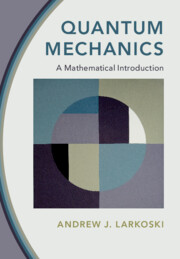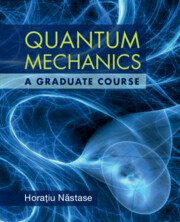Refine search
Actions for selected content:
3286 results in Quantum Physics, Quantum Information and Quantum Computation
34 - Fermi Surfaces without Quasiparticles
- from Part V - Correlated Metals
-
- Book:
- Quantum Phases of Matter
- Published online:
- 24 March 2023
- Print publication:
- 13 April 2023, pp 451-468
-
- Chapter
- Export citation
25 - Dualities of XY Models and U(1) Gauge Theories
- from Part IV - Fractionalization and emergent gauge fields II
-
- Book:
- Quantum Phases of Matter
- Published online:
- 24 March 2023
- Print publication:
- 13 April 2023, pp 295-311
-
- Chapter
- Export citation
3 - Dilute Bose Gas
- from Part I - Background
-
- Book:
- Quantum Phases of Matter
- Published online:
- 24 March 2023
- Print publication:
- 13 April 2023, pp 33-42
-
- Chapter
- Export citation
20 - Topological Insulators and Superconductors
- from Part III - Band topology
-
- Book:
- Quantum Phases of Matter
- Published online:
- 24 March 2023
- Print publication:
- 13 April 2023, pp 256-266
-
- Chapter
- Export citation
12 - Fermions and Bosons in One Spatial Dimension
- from Part I - Background
-
- Book:
- Quantum Phases of Matter
- Published online:
- 24 March 2023
- Print publication:
- 13 April 2023, pp 133-150
-
- Chapter
- Export citation
23 - Non-Abelian Ising Anyons
- from Part IV - Fractionalization and emergent gauge fields II
-
- Book:
- Quantum Phases of Matter
- Published online:
- 24 March 2023
- Print publication:
- 13 April 2023, pp 280-286
-
- Chapter
- Export citation
Part II - Fractionalization and emergent gauge fields I
-
- Book:
- Quantum Phases of Matter
- Published online:
- 24 March 2023
- Print publication:
- 13 April 2023, pp 151-152
-
- Chapter
- Export citation
22 - The Chiral Spin Liquid
- from Part IV - Fractionalization and emergent gauge fields II
-
- Book:
- Quantum Phases of Matter
- Published online:
- 24 March 2023
- Print publication:
- 13 April 2023, pp 274-279
-
- Chapter
- Export citation
16 - Z2 Gauge Theory
- from Part II - Fractionalization and emergent gauge fields I
-
- Book:
- Quantum Phases of Matter
- Published online:
- 24 March 2023
- Print publication:
- 13 April 2023, pp 196-220
-
- Chapter
- Export citation
Appendix B - Grassman Path Integral
-
- Book:
- Quantum Phases of Matter
- Published online:
- 24 March 2023
- Print publication:
- 13 April 2023, pp 476-480
-
- Chapter
- Export citation
2 - Fermi Liquid Theory
- from Part I - Background
-
- Book:
- Quantum Phases of Matter
- Published online:
- 24 March 2023
- Print publication:
- 13 April 2023, pp 21-32
-
- Chapter
- Export citation
29 - Kondo Impurity Model
- from Part V - Correlated Metals
-
- Book:
- Quantum Phases of Matter
- Published online:
- 24 March 2023
- Print publication:
- 13 April 2023, pp 351-367
-
- Chapter
- Export citation
11 - Relativistic Scalar Field: Correlation Functions
- from Part I - Background
-
- Book:
- Quantum Phases of Matter
- Published online:
- 24 March 2023
- Print publication:
- 13 April 2023, pp 122-132
-
- Chapter
- Export citation
31 - The Fractionalized Fermi Liquid
- from Part V - Correlated Metals
-
- Book:
- Quantum Phases of Matter
- Published online:
- 24 March 2023
- Print publication:
- 13 April 2023, pp 381-405
-
- Chapter
- Export citation
Part I - Background
-
- Book:
- Quantum Phases of Matter
- Published online:
- 24 March 2023
- Print publication:
- 13 April 2023, pp 19-20
-
- Chapter
- Export citation

Quantum Phases of Matter
-
- Published online:
- 24 March 2023
- Print publication:
- 13 April 2023

Quantum Mechanics
- A Paradigms Approach
-
- Published online:
- 11 February 2023
- Print publication:
- 15 September 2022
-
- Textbook
- Export citation

Quantum Mechanics
- A Mathematical Introduction
-
- Published online:
- 14 January 2023
- Print publication:
- 15 December 2022
-
- Textbook
- Export citation

Quantum Mechanics
- A Graduate Course
-
- Published online:
- 22 December 2022
- Print publication:
- 04 August 2022
-
- Textbook
- Export citation
Dedication
-
- Book:
- Quantum Mechanics
- Published online:
- 14 January 2023
- Print publication:
- 15 December 2022, pp v-v
-
- Chapter
- Export citation
